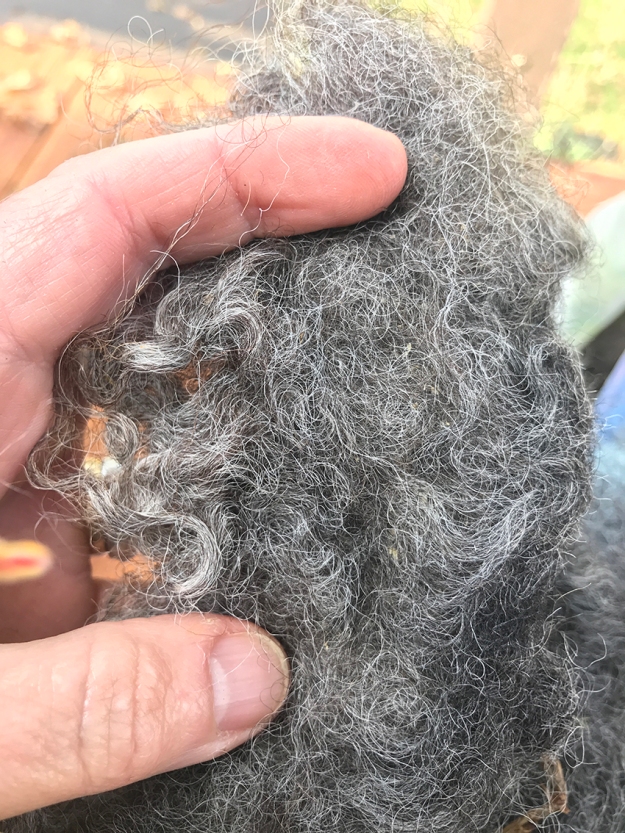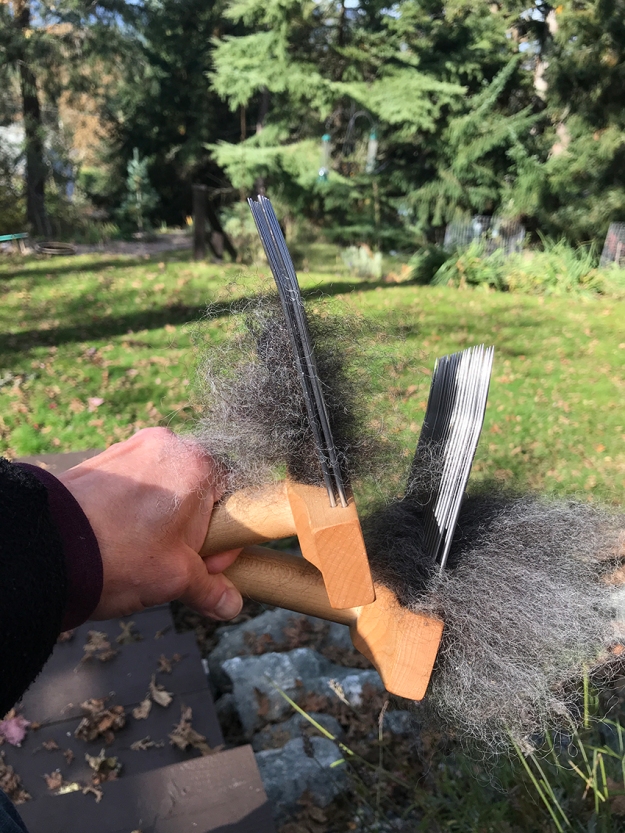Hullo, it’s been a while and I’m genuinely sorry about that. It’s been a really busy year: last winter my slowly-developing hobby of mending stuff and stitching stuff turned into preparing for and then teaching several workshops on ‘Boro and Visible Mending’, all while prepping for and then teaching two spinning workshops at ANWG 2019 (the Association of NorthWest Guilds Conference) in Prince George. And last month we had a wonderful, WONDERFUL holiday in the southwest US; I will try to put some photos up on the travel blog but fibre takes priority and it has been a very long time …
Knowing I’m looking for good double-coated fleece to investigate the spinning and weaving of medieval Greenland (I am still looking), someone (Pat M.) gave me a local Shetland fleece. The tog, the long outer coat, is not long enough for my purpose, but it’s not a bad primitive breed fleece. There’s some scurf, which is normal for primitive breeds: their fleece stops growing in late summer, so over the winter any dead skin just sits there whereas on a modern sheep breed with fleece that grows continually the fleece continually lifts the dead skin out and away. This is what that looks like on the shorn side of the raw fleece.
Primitive breed fleece also has a break point, a weakness where the new spring wool fibres continue on from the fibres that grew the previous year. This is the point where, if the sheep are allowed to roo (shed their fleece naturally), the old fleece breaks away and falls off the animal. The shearer has to wait for the rise, the growth of the new fleece, because the oils that accompany the new growth lubricate the shears. This means a clean sheep is shorn under the break point of the fleece, which means there’s a little bit of new wool that will break away naturally from the fleece to become nepps and other undesirable things in your yarn if you don’t get rid of it before you spin. It’s often a slightly different colour; in the photo below you can see some darker wool to the right, on the cut surface; that’s the short dark new wool I don’t want. 
So how can I get rid of it without hunting over the shorn side of the fleece to pick or pull off every bit of offending wool?
Comb it.
This is what combs excel at, sorting good from bad. When you comb all manner of undesirable stuff is trapped in the combing waste, from short proto-nepps to vegetation. Spin your combed wool worsted style, reasonably thin, and the tightly-packed aligned fibres doesn’t leave much room for vegetation: a constant rain of rubbish falls as you spin hand-combed top, all stuff you don’t want in your yarn.
But you do have to wash your fleece for this to work otherwise the lanolin and suint will hold all the rubbish in the wool. Grease fleece also tends to be sticky (the older the stash, the stickier it gets as light fractions in the lanolin evaporate away) which is not good for combs.
Here’s one of my Valkyrie Fine combs loaded with some washed Shetland, butt/shorn ends nearest my hand.

And here are the results of the first pass of rough combing. I’m not doing the classic English woolcomb comb and plank to evenly distribute fibre lengths, this project doesn’t require it. I just want parallel fibres and less rubbish. Note the bushy clump of short dark wool – combing waste – left in the top comb, the one that was first loaded. The comb below that (I only have two hands and one is holding the phone!) has the longer wool transferred by the combing process.

I do four passes, four transfers from comb to comb. In terms of fibre alignment I start with butt|tip, that becomes tip|butt, which becomes butt|tip, and finishes tip|butt, which means when I take the fibre off the combs and coil it into a little nest, the tips are the last thing to come off the comb – and this is the end that I start spinning. So this prep will be spun tip to butt. That means I’m spinning against the lie of the scales on the fibres, but with the taper (finer to thicker) of the fibres.
End result of the process is below, fibre ready to be removed from the comb with an array of combing waste below.

I saved all the waste. In earlier times very little wool was wasted. Combing ‘waste’ was further processed to be spun as weft in fabrics to be fulled, or even plied for use as warp in sturdy coarse fabrics.

I lashed handfuls of the waste, which contains many fine and short fibres, onto my Valkyrie Extra-Fine (three row) combs. Some of the scurf you can see below will be lost in the combing process, some will be left behind in the waste from this process, and some will end up in my yarn. Over time movement of the fabric and washing will break it down.

The result after two or three passes is shown below. I just pull this off the combs and put it in a bag to be spun from handfuls, semi-woollen.

And the end result of the process. Yarn! Mini-skeins of single. Incipient weft and warp straight off the bobbin reveals its fibre content and spinning style.

Nests of combed, aligned fibre, a bag of combed, sort-of-aligned fibre, and the yarn shown above after steaming to set the twist (can you see that the warp is now on the left?). Next stage will be to needle-weave a tiny sample on a piece of card or other tiny loom to see if I like the way it looks as fabric. I had hoped the weft would be slightly darker than the warp… I’ll keep you posted.

